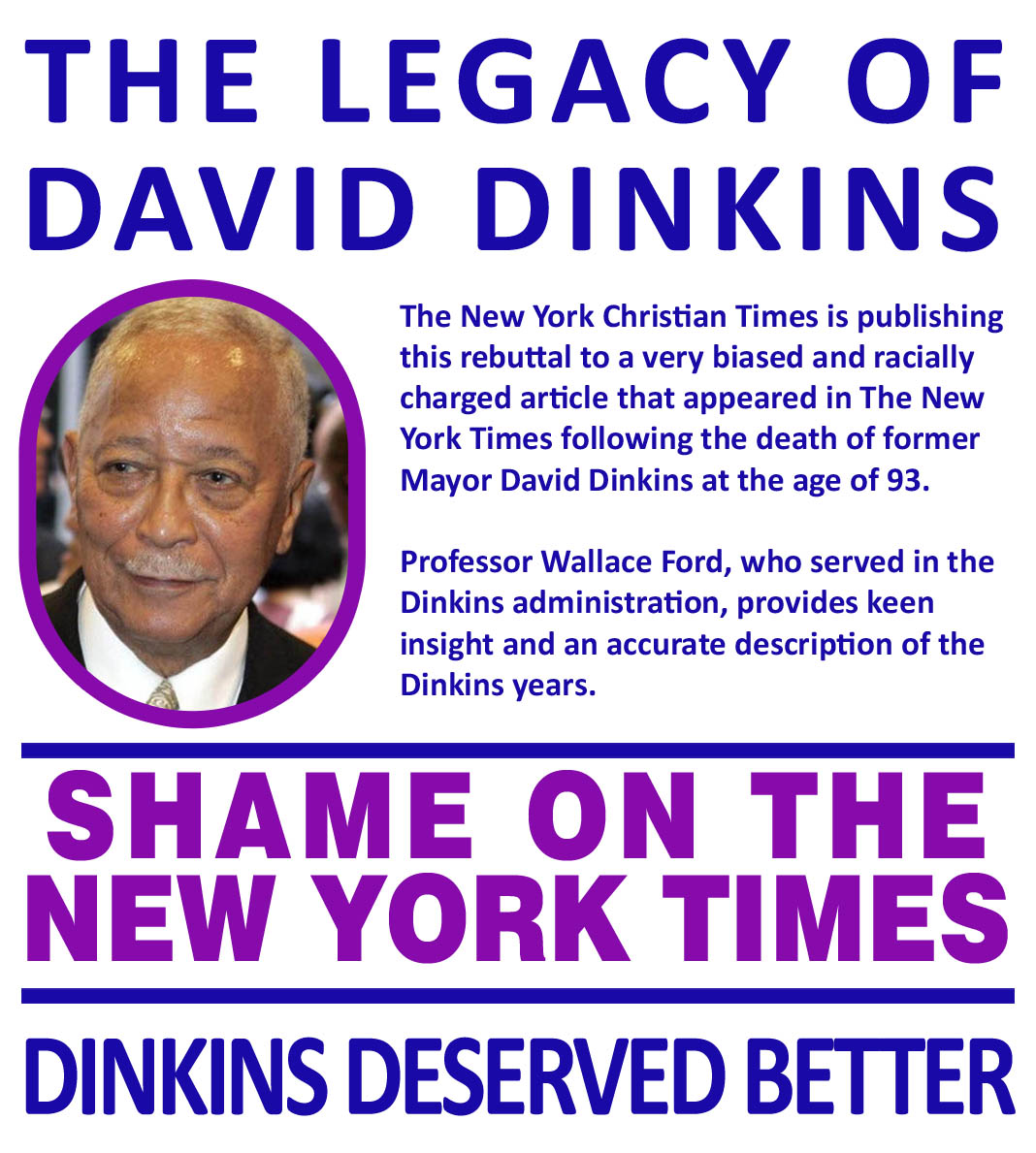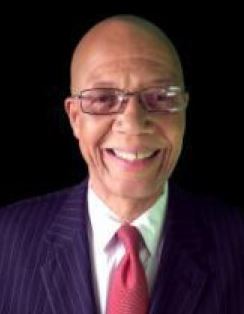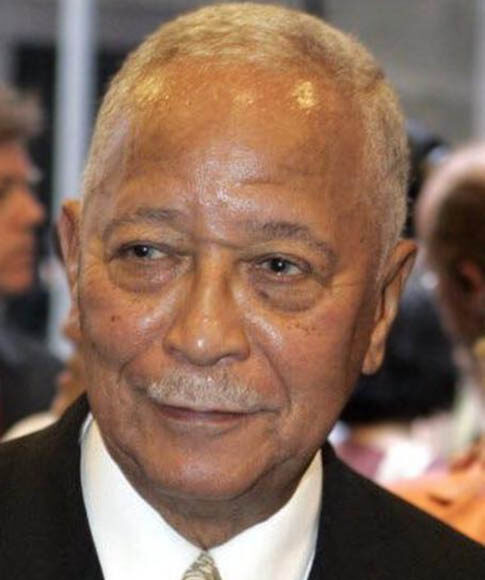The New York Christian Times is publishing this rebuttal to a very biased and racially charged article that appeared in The New York Times following the death of former Mayor David Dinkins at the age of 93. Professor Wallace Ford, who served in the Dinkins administration, provides keen insight and an accurate description of the Dinkins years.

There are few things in life of which you can be sure. One is that what you read below will never appear in The New York Times.
On November 24, 2020, less than 24 hours after former New York City Mayor David Dinkins died, The Times published an article by someone named Robert McFadden which was somewhere between a faux eulogy and a factually challenged hit job. Typically, when public figures pass away, the initial articles gently memorialize the departed individual. Opinions are like navels – everybody has one; but usually the opinion pieces come after a respectful pause – of at least a few days.
The Times sought to recycle half-truths, falsehoods, and the opinions of Mr. McFadden which, because the article appeared in the so-called newspaper of record, too many people will take this savaging of Dinkins to be true.
A full refutation of the Times article would give that article too much credit and credence but there are 10 points in this piece that warrant comment.
- McFadden states that Dinkins was “turned out by voters after one term….” The reality is that losing by 50,000 votes out of 2 million cast is not being “turned out”. And when the Trojan Horse of the Staten Island Secession Referendum supercharged the conservative White vote in that borough, it is a wonder that Dinkins only lost by 50,000 votes.
- Ed Koch and Fiorella LaGuardia, imperfect mayors that they were, were certainly more flamboyant than Dinkins. Flamboyance is not a character trait that distinguishes a public servant – keep in mind that Trump is flamboyant. But to suggest that they were “Gullivers bestriding him” is simply unkind and unworthy. And who, exactly are the “many historians and political experts” who expressed this opinion?
- To describe Dinkins as a caretaker mayor is simply a false and unsustainable narrative which may reflect Mr. McFadden’s opinion. Again, opinions are like navels – everyone has one. But he is not entitled to his own facts. Unless he is simply willing to ignore: (a) the Safe Cities Safe Streets program which added tens of thousands of police to the NYPD and began the decline in the crime rate which skyrocketed under that Gulliver named Koch and for which Giuliani later claimed credit; (b) a renewed focus on childhood education, which the childless Koch never advocated; (c) the establishment of New York’s first Minority and Women’s Business Program, which became the largest such municipally-based program in the United States – a program that was working so well that other “Gulliver” Giuliani ended the program within an hour of his taking the oath of office; (d) bringing the Democratic National Convention to New York at a time when New York needed some positive perspectives on the national stage; (e) establishing the Civilian Complaint Review Board over the virulent opposition of too many members of the NYPD; (f) establishing the inclusion of the LGBTQ community in the administration of the city; (g) establishing the National Tennis Center – the home of the U.S. Open – which has brought billions of dollars to New York over the past two decades; and (h) in what is a stunning illustration of the slanted and inaccurate characterization of the Dinkins administration, David Dinkins guided and led the city in the aftermath of the worst terrorist attack since 1920, the first World Trade Center bombing when this former Marine remained calm and without panic, which kept the city calm and without panic. Caretaker indeed.
- And not to dwell on McFadden’s false and dishonorable narrative, but a “caretaker” does not restore class and dignity to the office of Mayor as Dinkins did. And a “caretaker” doesn’t manage the City through a horrific financial crisis and lay the foundation for the economic recovery for which that “Gulliver” Giuliani claimed credit.
- McFadden refers to the revitalizing of Times Square as a minor accomplishment. The truth, of which he must know, is that in 1990 (after 12 years of leadership by that other “Gulliver” Ed Koch), Times Square was a neon Sodom and Gomorrah and the Times Square Business Improvement District which was totally supported by Dinkins transformed that area into a global tourist destination – ranking favorably with the Ginza in Tokyo and Trafalgar Square in London.
- McFadden refers to the “insurmountable legacy of Crown Heights” as being the reason for Dinkins being a one-term mayor. The reality is that Dinkins received the same percentage of White votes and Jewish votes in 1993 as he did in 1989; the difference was turnout. And without belaboring the point, one can ask why then Governor Mario Cuomo supported such a measure on the ballot when it would clearly not be to the benefit of his fellow Democrat Dinkins.
- The McFadden article is proof in black and white (no pun intended) that race was always the prism through which Dinkins was viewed by the New York press – the City Hall press corps was virtually all White at the time and constantly engaged in fully displaying his missteps and downplaying his success and achievements. If Dinkins walked on water, the headline in the New York Times would be “Dinkins Can’t Swim”.
- Somehow, in his narrative of the Dinkins years, Mr. McFadden couldn’t find space to mention how the City Hall police riot – at which Giuliani was a keynote speaker – inflamed the passions of race in this city. Cars were overturned, bystanders were assaulted, and Dinkins was hung in effigy as he was referred to as ‘the washroom attendant” (meant to be a racist insult and in this context sounds a lot like that “caretaker” characterization) by predominantly White police officers, too many of whom were on duty at the time.
- David N. Dinkins was deserving of better. The people who supported him and worked for him deserved better. The people who supported and loved him deserved better. The first Black mayor of the City of New York who served with dignity during some very undignified times deserved better.
The City of New York deserved better.

AUTHOR: Professor Wallace Ford
Professor Wallace Ford teaches at Medgar Evers College in the City University of New York. He is also the author of the Point of View blog – www.thewallaceford.com














